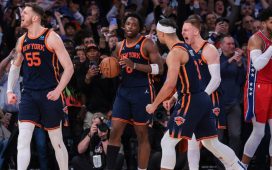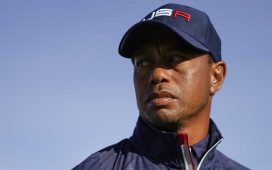
Avery Zweig never did get off the alternate list and into the field at the Olympic Club, but that doesn’t mean she had a bad week.
Getty Images
SAN FRANCISCO — One hundred fifty-six players teed off in the first round of the U.S. Women’s Open on Thursday. Avery Zweig wasn’t one of them.
Although the 14-year-old went through all the preparations for the event — practice rounds, early wake-up calls, dialing in her swing — Zweig didn’t get a chance to strike a shot in competition at The Olympic Club. Such is life as the first alternate.
It’s no sweat for Zweig, though. This journey to San Francisco never was predictable.
“I’m no stranger to emotional roller coasters as far as the qualifying process goes,” Zweig said of how she got to the dubious spot of first alternate.
As she tells it, her qualifier in Texas had no live scoring and turned into a two-day marathon. She ended up in a playoff for the last spot, but when her opponent went birdie-birdie, Zweig was relegated to alternate status.
“It’s been very up and down,” she added.
But when she found out she was No. 1 on the alternate list, she made the trip west in hopes of sneaking into the field at the eleventh hour.
Even being on the dreaded alternate list, U.S. Open week has some perks. Zweig had access to the practice facilities and player areas all week (“there’s a lot of really good food in there”), and she got to play practice rounds as if she were in the field.
One such practice round had her paired with first-round leader Mel Reid, from whom Zweig tried to absorb all the knowledge she could.
“It was really cool to watch them play,” she says. “I got to see the improvements that I can make to where I can compete at this level.”
One of those improvements is to change her thinking on the course. A U.S. Open demands players to shape their shots, but Zweig prefers to play a straight ball. She insists getting away from that linear mindset will do her good in the future.
But while Zweig’s well-seasoned practice-round playing partners got to come to the course on Thursday with a tee time in hand, Zweig came to Olympic in purgatory.
Tee times started at 7 a.m. in the opening round, so Zweig prepared for the day as if she were in the first group. Her alarm went off at 5 and she was out the door a half-hour later. She ate breakfast, hit balls and worked on her short game like she would for any other round.

Zweig waits for some good news.
Zephyr Melton
The 7 a.m. tee time came and went with no WDs … and then the 7:11 a.m. group, and the 7:15 group after that. After the entire first wave went off, there was no good news for Zweig. So, she retreated back to the player’s lounge and mentally prepared to do it again in hopes of good news in the second wave.
Unfortunately for Zweig, the second wave was much the same. She warmed up in hopes of hearing good news, but the good news never came. Instead of taking on the U.S. Open test this weekend, she’ll instead have to enjoy the action from afar.
In spite of it all though, Zweig’s positive outlook has remained unchanged.
“Playing in the U.S. Open would obviously have been fantastic,” Zweig said. “But you don’t have to play in it to experience how difficult it is.”












